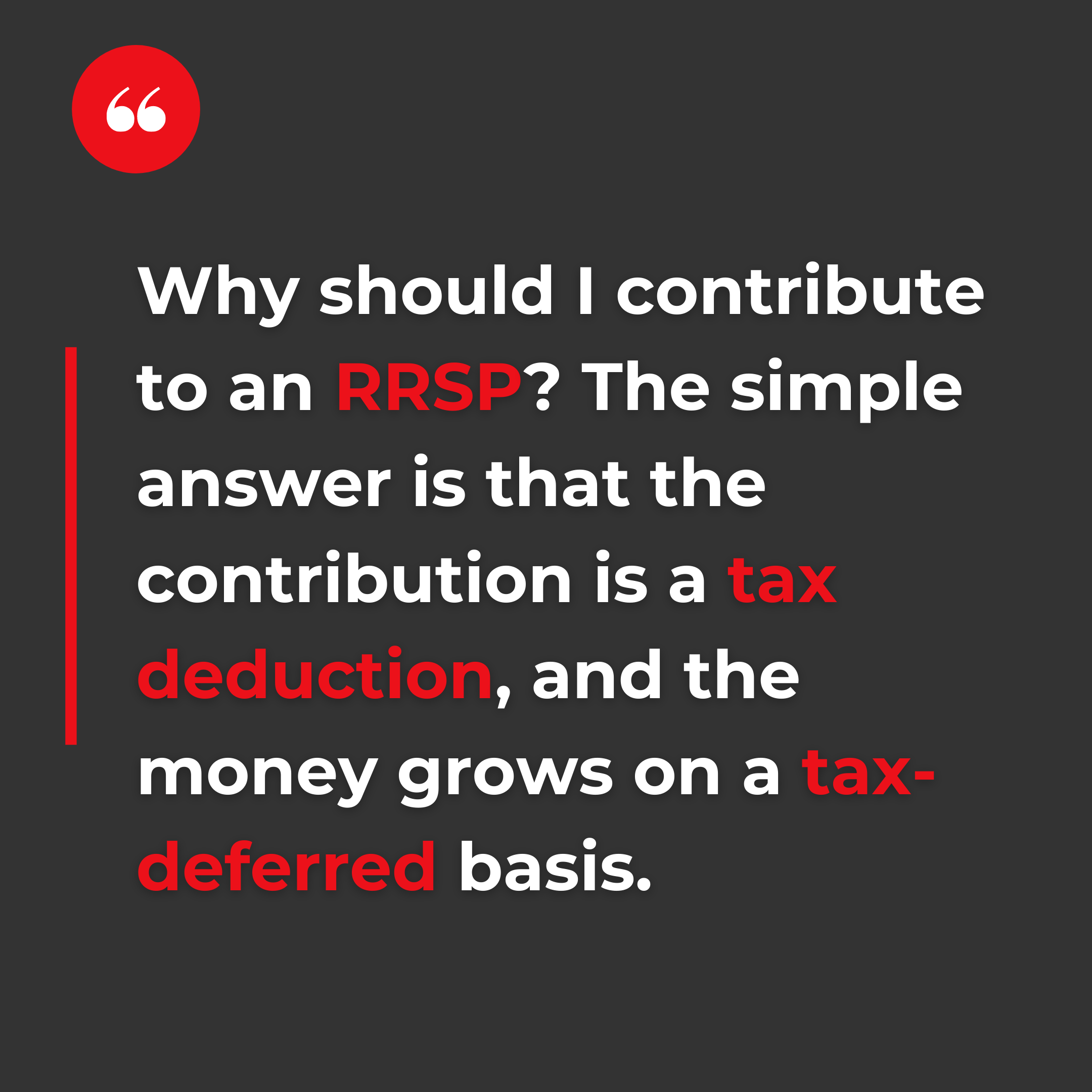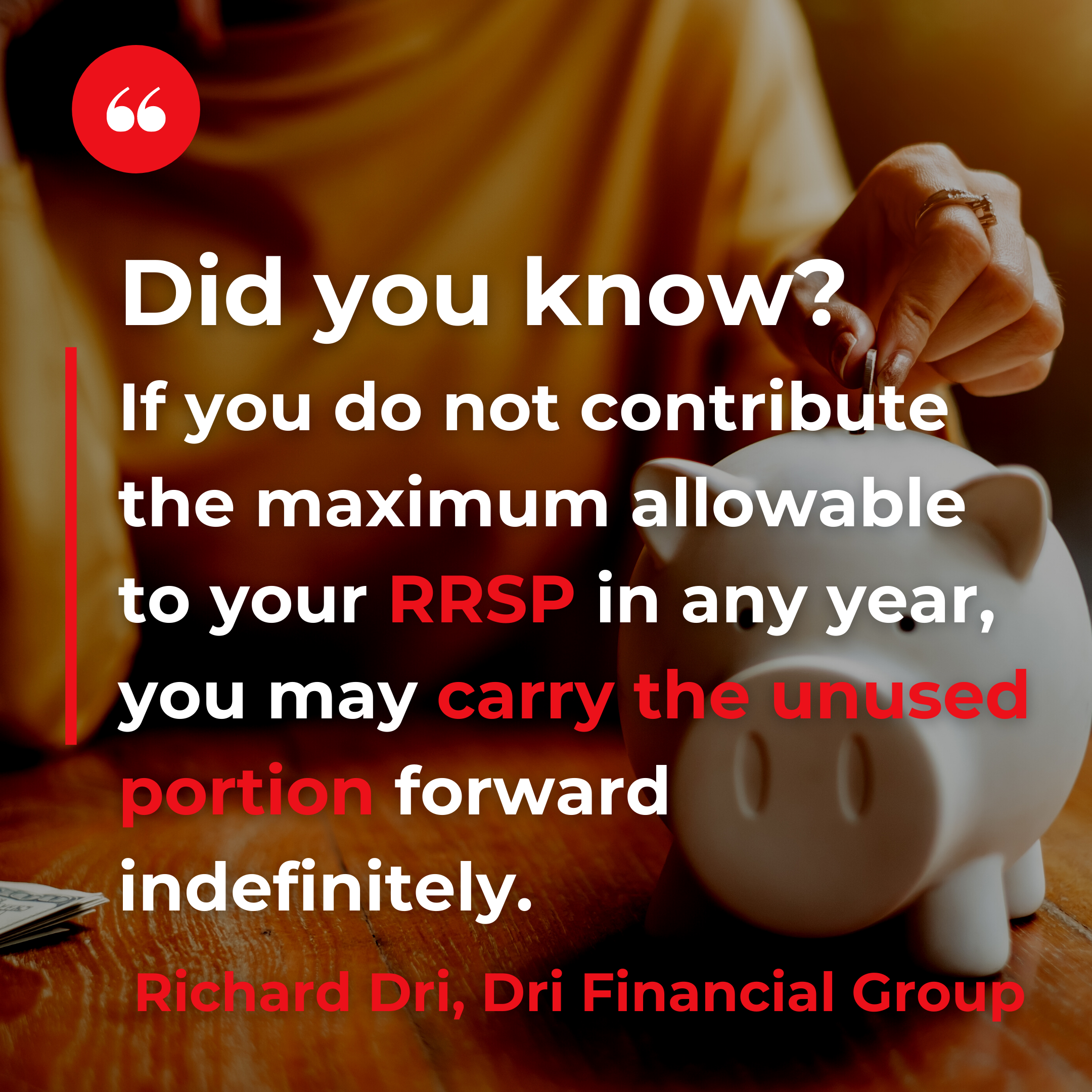A Toronto Wealth Advisor Answers your RRSP questions
What do you need to know about your RRSP in 2021?

It’s RRSP season. Here are the answers to all of your questions.
Canada has five seasons: Winter, Spring, Summer, Fall and RRSP. We are now in full RRSP season. Get out your 2019 tax returns and start thinking about an RRSP contribution.
Quick tip: If you don’t want to read this entire blog, just take this away:
THE RRSP CONTRIBUTION DEADLINE FOR THE 2020 TAX YEAR IS MARCH 1st—AND THE MAXIMUM CONTRIBUTION LIMIT IS $27,230.
Now, if you do keep reading, I promise you will learn a lot more about RRSPs. To make it as easy as possible, I have organized this blog in a Q&A format. You’re asking the questions and I’m answering them.
Here’s what a financial advisor would like you to know about your RRSP:
1. I don’t have time to do the math. Where do I find my RRSP limit?
You can quickly figure out your personal RRSP limit online or over the phone.
RRSP limits can be found on your 2019 Notice of Assessment, online at the Canadian Revenue Agency using My Account for Individuals, or from the tax information phone service (1-800-267-6999).
2. Why should I contribute to an RRSP?
The simple answer is that the contribution is a tax deduction, and the money grows on a tax-deferred basis.
Here’s an example:
Assuming a taxable income of $152,000 and an RRSP contribution of $27,230, the tax savings is $11,771 (for an Ontario resident).
Click here and calculate your own tax savings.
And while the $27,230 is invested in your RRSP, tax on any growth is deferred until the funds are withdrawn, which could be years down the road.

3. I have not spent very much during the last 12 months. Can I contribute more than my 2020 limit?
Maybe...
If you do not contribute the maximum allowable to your RRSP in any year, you may carry the unused portion forward indefinitely.
For example, if your limit in 2019 was $20,000 and you managed to contribute $15,000, then you are allowed to carry forward to 2020 (or beyond) the unused limit of $5,000.

4. I don’t have the money to contribute. Can I borrow?
Absolutely. And interest rates are exceptionally low today.
For example, let’s assume you borrow $10,000 for an RRSP contribution with these conditions:
- an interest rate of 2.45%
- an investment growth rate of 6%
- a two-year payment plan
- a 35% marginal tax rate
- 25 years before retirement
- the refund is applied to the loan
Under these assumptions, the cost of the loan is $139.30 and the $10,000 loan would be worth $42,919. Click here and run your own calculations.

5. Hey, shouldn’t I contribute to my TFSA first?
It depends.
If you think you’ll need the money in the short run, then I suggest investing in a TFSA. But if you plan to leave the funds until retirement (and beyond), and your taxable income is greater than $50,000, then the RRSP is generally best.
The RRSP provides an upfront tax deduction, and the funds grow tax deferred until withdrawn. The TFSA provides no upfront tax deduction but allows the funds to grow tax free.
So the answer depends on the time frame of the investment and your marginal tax rate.
6. Should I pay down the mortgage or contribute to an RRSP?
The answer depends on your risk tolerance.
I’ll use an example to answer this question. Let’s assume the mortgage rate is 3% .
Every time you make an extra mortgage payment, you reduce the amount owed on the principle. If the interest rate is 3%, paying it off is like getting a guaranteed 3% return. If you feel you can get a better return in the stock market, then buy stocks. But if you’re not sure, take the guaranteed return and pay off the mortgage.

7. I’m 71. Can I still contribute?
Yes.
If you have contribution room, you can contribute to your RRSP until December 31 of the year you turn 71 (and to your spousal RRSP until December 31 of the year your spouse or common-law partner turns 71 ).
8. Can you show me the math for calculating my RRSP limit?
Sure.
Here’s how the CRA calculates your 2020 RRSP contribution limit:
- 18% of earned income for the 2019 tax year, up to the $27,230 maximum
- Minus the “pension adjustment” amount, for employees in a registered pension plan (RPP) or deferred profit-sharing plan (DPSP) in 2019
- Minus any “past service pension adjustment,” for participants in an RPP or DPSP in 2019
- Plus any “past service pension adjustment” reversals in 2019
- Plus any unused deduction room carried forward from 2018
So, if you earned $151,280 or more in 2019, your contribution limit in 2020 is the maximum contribution limit of $27,230 (before any pension adjustment).
9. What’s earned income?
Earned income is the money from salaries, wages, tips, and any self-employment income.
It also includes net rental income, spousal support, royalties, research grants, and income from unemployment benefit plan payments.
10. What’s a pension adjustment (PA)?
If the employer offers a registered pension plan or a deferred plan, the amount contributed to these plans is subtracted from the RRSP limit.

This avoids doubling up pension contributions by contributing at work through a RPP and/or DPSP and then also individually through an RRSP.
The PA is found on your 2019 T4 slip.
11. What’s a past service pension adjustment (PSPA)?
A PSPA is an event that causes an employee’s post-1989 RPP benefits to increase (e.g., the employee is credited with additional service or the benefit formula is retroactively increased).
By subtracting this amount, the overall limit of a retirement savings plan is maintained at 18% of earned income.
The PSPA is also found on your 2019 T4 slip.
12. What’s a pension adjustment reversal (PAR)?
A PAR is used when an employee departs a DPSP or an RPP as an employee.
For example, if the employee leaves the plan before the employer’s contributions are vested.

PARs increase RRSP limits and reflect that portion of retirement savings that were reinstated.
PARs can also be found on the 2019 TA slip.
13. What’s my unused deduction room carried forward limit?
Fortunately, if you don’t have the funds to make your maximum contribution (or feel that you will be in a higher tax bracket in a future year), the used amount can be carried forward indefinitely.
I hope I addressed all your possible questions.
If you’re not sure if you should contribute, let us prepare a retirement projection and determine if your retirement goals are realistic and on target.
Never Retire Profile
Sure, Tom Brady isn’t past the usual retirement age you and I might consider. But at 43-years-old, Brady is one of the oldest players in NFL history. And he’s still playing at an exceptional level. And he’s the first player in NFL history to win seven Super Bowls. Brady arrived in Tampa Bay to play with his new squad after a so-so final season with New England and much speculation as to whether he would retire—and brought Rob Gronkowski out of retirement to join him. The rest is literally history. Brady led the Buccaneers to the Super Bowl and then defeated Kansas City 31-9. After the win, the Patriots gracefully tweeted, “Congratulations to the greatest of all time.” What’s next for the champ? The way this season ended, it’s unlikely he’ll put his feet up. Why retire when you love what you do and still have the talent and drive to do it?
The process of finding a wealth advisor can be overwhelming. It is our job to make that process simpler and easier. Dri Financial Group’s proprietary Wealth Navigator Process is designed with you in mind. It’s structured framework helps you make an informed decision and feel confident in our team and management practices before we get started.
We offer you a range of services from creating bespoke financial plans and providing investment advice to helping you take advantage of our investment models. If you would like more information on the Wealth Navigator Process or our team, call me any time at 416.355.6370 or email me at richard.dri@scotiawealth.com.
—
Beyond helping you manage your finances, we take pride in motivating, educating and helping you expand your financial literacy. We are here to answer any questions you have and to help you feel in control of your financial destiny.
If you are ready to dive deeper into your financial literacy journey, we have a wide range of free tools and educational resources available.
- Subscribe to our Never Retire Newsletter
- Contact us to order a complimentary e-book
- Check-out our latest Wealth Navigator Podcast
- Follow me on LinkedIn